Analys
Ultra tight market for medium sour crude and middle distillates

The world is craving for medium sour crude, middle distillates and heavier products. Deep cuts by OPEC+ has created a super tight market for medium to heavy crudes. So tight that Dubai crude now trades at a USD 0.6/b premium to Brent crude rather than a normal discount. All of Russia’s crudes are now trading above the USD 60/b price cap set by the US. Scarcity of such crudes, rich on middle distillates and heavy products, is naturally leading to a scarcity of middle distillates and heavier products. Global inventories of such products are now very low and refining margins are skyrocketing with diesel in Europe now at USD 125/b. There is no sign that Saudi Arabia will shift away from its current ”price over volume” strategy as it is expected to lift its official selling prices for October. Crude oil at USD 85/b is a blissful heaven for Saudi Arabia. As long as US shale oil is shedding drilling rigs at a WTI oil price of USD 80/b there is no reason for Saudi Arabia to fear any shale oil boom which potentially could rob if of market shares. So ”price over volume” is the name of the game.

Production by OPEC+ has declined by 2.7 m b/d from Sep-2022 to Aug-2023. Most of this reduction has taken place since February this year. Global demand on the other hand has increased by 2.4 m b/d from Q3-2022 to Q3-2023. This counter move between supply from OPEC+ vs. global demand has been partially eased by a 1.4 m b/d increase in supply by OECD producers, mostly US shale oil (light sweet crude).
There has thus been a massive tightening in the supply of medium sour crude (medium weight and sulfur > 1%) from OPEC+. Naturally so because this is the type of crude which OPEC+ predominantly is producing. So when the organisation makes deep cuts it leads to a tightening of the medium sour crude market.
The situation has been exacerbated by several factors. The first is Europe which no longer is importing neither crude nor oil products from Russia. The EU28 used to import 4.3 m b/d of crude and products from Russia before the war in Ukraine. Predominantly medium sour crude (Urals), lots of diesel but also lots of heavier components like VGO and different kinds of heavy refinery residues like bunker oil etc. Refineries are huge, complex, specialized machines which are individually tailor made for specific tasks and feed stocks. Without the specific feed stocks they were made for they typically cannot run optimally and have to run at reduced rates thus churning out less finished oil products. Europe has to some degree been able to import medium sour crude from the Middle East and other places to replace the 4.3 m b/d of lost supply from Russia, but it has also been forced to replace it with light sweet crude from the US which is yielding much less diesel or heavier products. The Vacuum Gasoil (VGO) and other heavy feed stocks which the EU used to import from Russia were typically converted to diesel products in deep conversion units. The second factor which has added to the problem is that more than 5 m b/d of global refining capacity has been decommissioned globally since 2020. Global refining capacity actually contracted in 2021 for the first time!
But bottom line here is that the global market for medium sour crude is now super tight. Predominantly as a result of deep cuts by OPEC+. This has amplified the factors above and led to a super tight situation in medium heavy to heavy products (diesel, jet, bunker oil, etc). It is so tight that bunker oil (HSFO 3.5%) in Europe recently traded at a premium to Brent crude rather than a normal discount of USD 10-20/b. This hasn’t happened since the 1990ies! Another sign of the tightness in medium sour crude is that Dubai crude (API = 31, Sulfur = 2%) now is trading at a premium to Brent crude (API = 38, Sulfur = 0.5%) versus a normal discount of more than USD 2/b.
Global middle distillate stocks are very low as we now head into winter. Inventories of middle distillates and jet fuel in the US is almost equally low as they were one year ago.
The tightness in medium sour crude and diesel products has sent refinery margins skyrocketing. The price of diesel in Europe ARA is now standing at USD 125.2/b. That is down from the crazy prices we had one year ago when diesel prices in Europe almost reached USD 180/b. But current diesel price is on par with the price of diesel from 2011 to 2014 when Brent crude averaged USD 110/b. The diesel refining premium in ARA is now USD 40/b and the premium for jet fuel is USD 45/b. Refineries usually make a profit on diesel, jet and gasoline, a loss on bunker oil and a total refining margin for turning crude oil to products of maybe just USD 5/b before operating and capital cost leaving them with limited or even negative margins overall. Now they are making a killing. As a result they will buy as much crude as they can and turn it into the needed products. What they want more than anything is medium sour crudes which have rich contents of middle distillates. But the supply of that crude is now super tight due to deliberate cuts by Saudi Arabia and now also Russia.
There is no sign that Saudi Arabia and Russia will back down any time soon. Saudi Arabia is about to set its official selling prices (OSPs) for October and indications are that they will increase their prices. That implies that Saudi Arabia will continue its ”price over volume” strategy. No signs that they will change on this any time soon. US shale oil producers are still shedding drilling rigs and supply growth there is slowing = Power to OPEC+ to control the market.
Saudi Arabia will also decide over the coming days what they will do with their unilateral production cut for October. Will it roll forward their current production of 9 m b/d or will they add some crude and lift it to for example 9.5 m b/d? Hard to say, but what is clear is that the global market currently is craving for more diesel, heavy products and medium sour crude. Our view is that Saudi Arabia will not risk driving crude oil prices to USD 100 – 110/b or higher through deliberate cuts as this will lead to elevated political storm from the US and maybe also from China. We think that Saudi Arabia is utterly happy with the current oil price of USD 85/b and want to keep it at that level. Getting it exactly right is of course tricky, but they do have the capacity to at least get it ballpark right.
Russia should be super happy. The tight medium sour crude market has sent the price of all their crude exports to above the USD 60/b cap. The price of Urals has increased from USD 50/b in May to now USD 71/b. This is of course a headache for the western who is trying to limit Russian oil revenue.
Deep cuts by OPEC+ over the past year. In total 2.7 m b/d since Sep 2022. But accelerating cuts since February 2023. Deliberate cuts by Saudi Arabia and in part by Russia. It has created a super tight market for medium sour crude as global demand has rallied 2.4 m b/d over the past year.
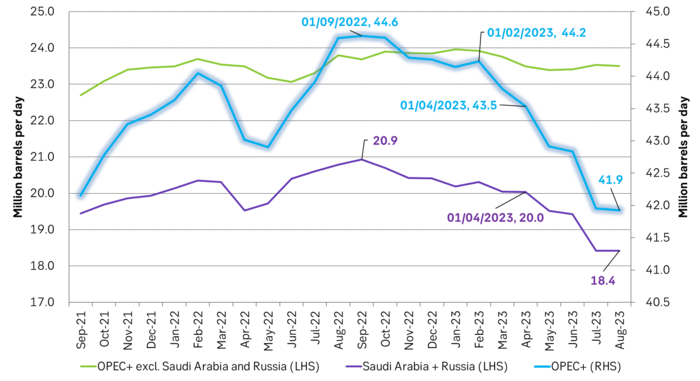
Price spread Dubai – Brent. Dubai usually trades at a discount to Brent crude. Now it trades at a premium of USD 0.6/b. Highly unusual! A sign of a very tight medium sour crude oil market.
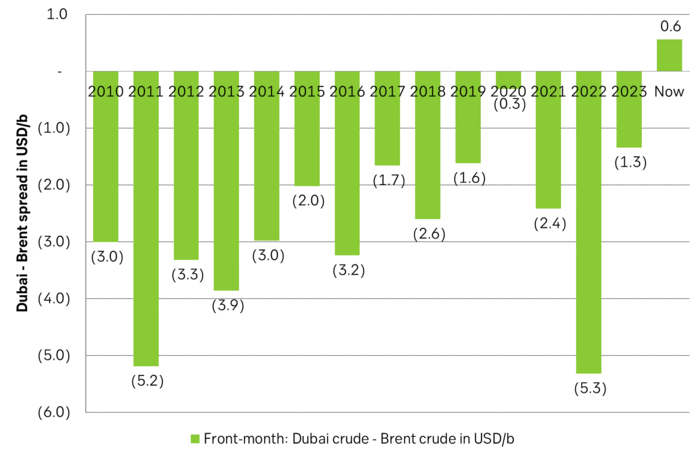
The price discount for Russian Urals crude is evaporating as the market for medium sour crude oil has tightened.
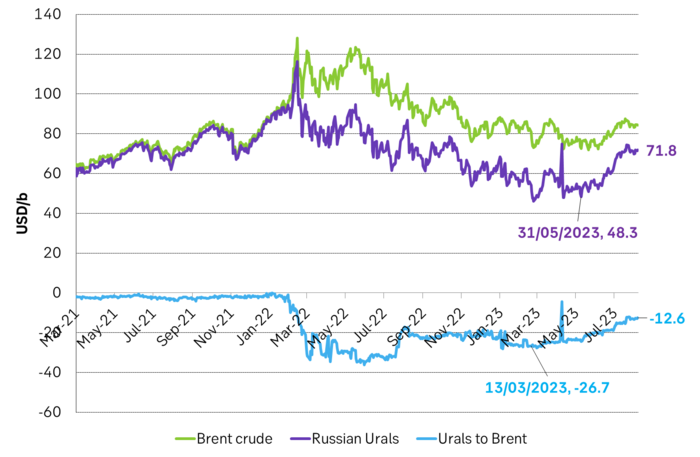
ARA diesel prices have rallied since their low point in April. Diesel in ARA now costs USD 125/b and equally much as it did from 2011 to 2014 when Brent crude traded at USD 110/b.
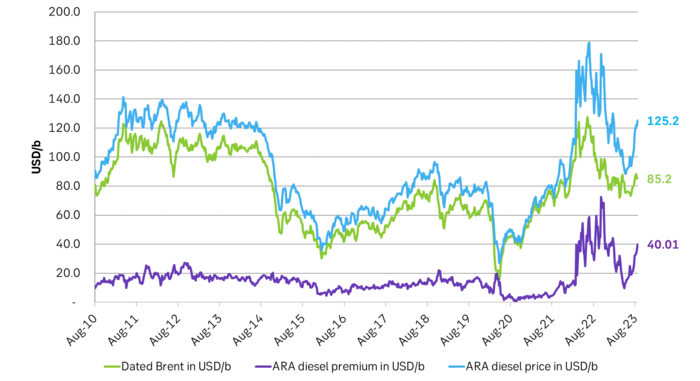
Refineries are making a killing as refining margins for diesel, jet and gasoline have skyrocketed while the usual loss making component, bunker oil, now almost trades on par with Brent crude. Refineries, the primary buyers of crude, will buy as much crude oil as they can to make yet more money. This should help to keep demand for crude oil elevated and thus prices for crude oil elevated.
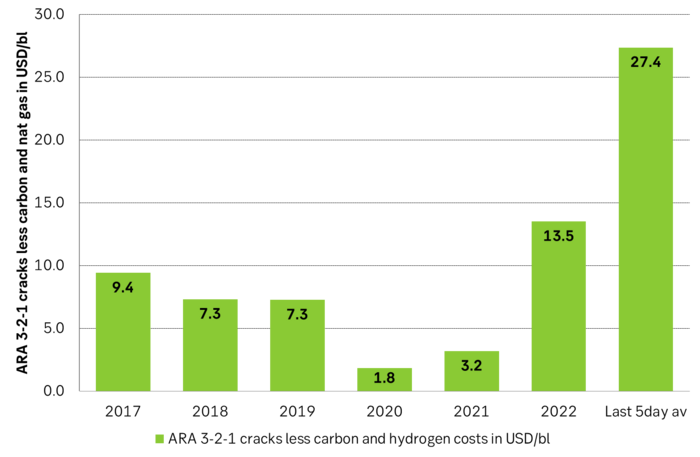
Analys
Tightening fundamentals – bullish inventories from DOE

The latest weekly report from the US DOE showed a substantial drawdown across key petroleum categories, adding more upside potential to the fundamental picture.

Commercial crude inventories (excl. SPR) fell by 5.8 million barrels, bringing total inventories down to 415.1 million barrels. Now sitting 11% below the five-year seasonal norm and placed in the lowest 2015-2022 range (see picture below).
Product inventories also tightened further last week. Gasoline inventories declined by 2.1 million barrels, with reductions seen in both finished gasoline and blending components. Current gasoline levels are about 3% below the five-year average for this time of year.
Among products, the most notable move came in diesel, where inventories dropped by almost 4.1 million barrels, deepening the deficit to around 20% below seasonal norms – continuing to underscore the persistent supply tightness in diesel markets.
The only area of inventory growth was in propane/propylene, which posted a significant 5.1-million-barrel build and now stands 9% above the five-year average.
Total commercial petroleum inventories (crude plus refined products) declined by 4.2 million barrels on the week, reinforcing the overall tightening of US crude and products.


Analys
Bombs to ”ceasefire” in hours – Brent below $70

A classic case of “buy the rumor, sell the news” played out in oil markets, as Brent crude has dropped sharply – down nearly USD 10 per barrel since yesterday evening – following Iran’s retaliatory strike on a U.S. air base in Qatar. The immediate reaction was: “That was it?” The strike followed a carefully calibrated, non-escalatory playbook, avoiding direct threats to energy infrastructure or disruption of shipping through the Strait of Hormuz – thus calming worst-case fears.

After Monday morning’s sharp spike to USD 81.4 per barrel, triggered by the U.S. bombing of Iranian nuclear facilities, oil prices drifted sideways in anticipation of a potential Iranian response. That response came with advance warning and caused limited physical damage. Early this morning, both the U.S. President and Iranian state media announced a ceasefire, effectively placing a lid on the immediate conflict risk – at least for now.
As a result, Brent crude has now fallen by a total of USD 12 from Monday’s peak, currently trading around USD 69 per barrel.
Looking beyond geopolitics, the market will now shift its focus to the upcoming OPEC+ meeting in early July. Saudi Arabia’s decision to increase output earlier this year – despite falling prices – has drawn renewed attention considering recent developments. Some suggest this was a response to U.S. pressure to offset potential Iranian supply losses.
However, consensus is that the move was driven more by internal OPEC+ dynamics. After years of curbing production to support prices, Riyadh had grown frustrated with quota-busting by several members (notably Kazakhstan). With Saudi Arabia cutting up to 2 million barrels per day – roughly 2% of global supply – returns were diminishing, and the risk of losing market share was rising. The production increase is widely seen as an effort to reassert leadership and restore discipline within the group.
That said, the FT recently stated that, the Saudis remain wary of past missteps. In 2018, Riyadh ramped up output at Trump’s request ahead of Iran sanctions, only to see prices collapse when the U.S. granted broad waivers – triggering oversupply. Officials have reportedly made it clear they don’t intend to repeat that mistake.
The recent visit by President Trump to Saudi Arabia, which included agreements on AI, defense, and nuclear cooperation, suggests a broader strategic alignment. This has fueled speculation about a quiet “pump-for-politics” deal behind recent production moves.
Looking ahead, oil prices have now retraced the entire rally sparked by the June 13 Israel–Iran escalation. This retreat provides more political and policy space for both the U.S. and Saudi Arabia. Specifically, it makes it easier for Riyadh to scale back its three recent production hikes of 411,000 barrels each, potentially returning to more moderate increases of 137,000 barrels for August and September.
In short: with no major loss of Iranian supply to the market, OPEC+ – led by Saudi Arabia – no longer needs to compensate for a disruption that hasn’t materialized, especially not to please the U.S. at the cost of its own market strategy. As the Saudis themselves have signaled, they are unlikely to repeat previous mistakes.
Conclusion: With Brent now in the high USD 60s, buying oil looks fundamentally justified. The geopolitical premium has deflated, but tensions between Israel and Iran remain unresolved – and the risk of missteps and renewed escalation still lingers. In fact, even this morning, reports have emerged of renewed missile fire despite the declared “truce.” The path forward may be calmer – but it is far from stable.
Analys
A muted price reaction. Market looks relaxed, but it is still on edge waiting for what Iran will do

Brent crossed the 80-line this morning but quickly fell back assigning limited probability for Iran choosing to close the Strait of Hormuz. Brent traded in a range of USD 70.56 – 79.04/b last week as the market fluctuated between ”Iran wants a deal” and ”US is about to attack Iran”. At the end of the week though, Donald Trump managed to convince markets (and probably also Iran) that he would make a decision within two weeks. I.e. no imminent attack. Previously when when he has talked about ”making a decision within two weeks” he has often ended up doing nothing in the end. The oil market relaxed as a result and the week ended at USD 77.01/b which is just USD 6/b above the year to date average of USD 71/b.

Brent jumped to USD 81.4/b this morning, the highest since mid-January, but then quickly fell back to a current price of USD 78.2/b which is only up 1.5% versus the close on Friday. As such the market is pricing a fairly low probability that Iran will actually close the Strait of Hormuz. Probably because it will hurt Iranian oil exports as well as the global oil market.
It was however all smoke and mirrors. Deception. The US attacked Iran on Saturday. The attack involved 125 warplanes, submarines and surface warships and 14 bunker buster bombs were dropped on Iranian nuclear sites including Fordow, Natanz and Isfahan. In response the Iranian Parliament voted in support of closing the Strait of Hormuz where some 17 mb of crude and products is transported to the global market every day plus significant volumes of LNG. This is however merely an advise to the Supreme leader Ayatollah Ali Khamenei and the Supreme National Security Council which sits with the final and actual decision.
No supply of oil is lost yet. It is about the risk of Iran closing the Strait of Hormuz or not. So far not a single drop of oil supply has been lost to the global market. The price at the moment is all about the assessed risk of loss of supply. Will Iran choose to choke of the Strait of Hormuz or not? That is the big question. It would be painful for US consumers, for Donald Trump’s voter base, for the global economy but also for Iran and its population which relies on oil exports and income from selling oil out of that Strait as well. As such it is not a no-brainer choice for Iran to close the Strait for oil exports. And looking at the il price this morning it is clear that the oil market doesn’t assign a very high probability of it happening. It is however probably well within the capability of Iran to close the Strait off with rockets, mines, air-drones and possibly sea-drones. Just look at how Ukraine has been able to control and damage the Russian Black Sea fleet.
What to do about the highly enriched uranium which has gone missing? While the US and Israel can celebrate their destruction of Iranian nuclear facilities they are also scratching their heads over what to do with the lost Iranian nuclear material. Iran had 408 kg of highly enriched uranium (IAEA). Almost weapons grade. Enough for some 10 nuclear warheads. It seems to have been transported out of Fordow before the attack this weekend.
The market is still on edge. USD 80-something/b seems sensible while we wait. The oil market reaction to this weekend’s events is very muted so far. The market is still on edge awaiting what Iran will do. Because Iran will do something. But what and when? An oil price of 80-something seems like a sensible level until something do happen.
-

 Nyheter4 veckor sedan
Nyheter4 veckor sedanStor uppsida i Lappland Guldprospekterings aktie enligt analys
-

 Nyheter4 veckor sedan
Nyheter4 veckor sedanSilverpriset släpar efter guldets utveckling, har mer uppsida
-

 Nyheter3 veckor sedan
Nyheter3 veckor sedanUppgången i oljepriset planade ut under helgen
-

 Nyheter2 veckor sedan
Nyheter2 veckor sedanMahvie Minerals växlar spår – satsar fullt ut på guld
-

 Nyheter3 veckor sedan
Nyheter3 veckor sedanLåga elpriser i sommar – men mellersta Sverige får en ökning
-

 Analys3 veckor sedan
Analys3 veckor sedanVery relaxed at USD 75/b. Risk barometer will likely fluctuate to higher levels with Brent into the 80ies or higher coming 2-3 weeks
-

 Nyheter2 veckor sedan
Nyheter2 veckor sedanOljan, guldet och marknadens oroande tystnad
-

 Nyheter2 veckor sedan
Nyheter2 veckor sedanJonas Lindvall är tillbaka med ett nytt oljebolag, Perthro, som ska börsnoteras










